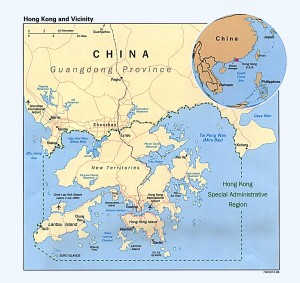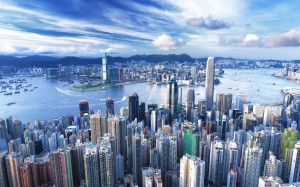The Chinese island of Hong Kong has seen periods of drastic change over the last two hundred years. It became a colony of the United Kingdom in 1842, and the British maintained control until 1997, when China appropriated it as a “Special Administrative Region.” Education has been strongly influenced by its unique location and history. The region is less than twenty miles away from Mainland China; situated on the southeastern coastline. Hong Kong’s main port, Victoria Harbor, is a focal point of global trade. Its expansive, deep waterways and placement along South China Seaways drew international commerce and positioned it for rapid growth and development. In the 19th century, this location between India, northern China, and the West made it vital to trade taking place between these areas. Where there is trade, there are people; and where there are people, there must be education. As a result, the growth in population led to the early Hong Kongese institutions of education. These initial models were based upon voluntary and philanthropic work. They had a unique Chinese/British influence because of the region’s proximity to China and its position as a British Colony, although a western education style accounted for the major parts of education development. This certainly consisted of the inclusion of Christian beliefs and although curriculums did not center on religious texts, early 19th century classrooms did make sure that all students were given a bible. Government and education officials evolved from British diplomats to clergymen and in 1850 Anglican Bishop George Smith was appointed as superintendant of schools. This phase witnessed a strong influence on education as more and more members of the school board, teachers, and high-level officials identified as Christians. However, some Chinese did resist this western influence and as private schools began to emerge, those that could afford it sent their children there, so that they would be exposed to less government and Christian interference. The century closed with an unsettled educational scene. British parents wanted their kids separated from the Chinese kids, wealthy Chinese parents wanted their kids separated from poor Chinese kids, quality teaching and facilities were difficult to find, and there was an uneven amount of government grant money that was being distributed to schools.
As the 20th century turned, Hong Kong families started to value the British education system more and more. It offered better English instruction and proved to better prepare students for higher education, professional training, or additional study abroad. In addition, government funding was only going to schools being administered through Western models, so the quality of schooling was above and beyond that of the traditional Chinese institutions. Government officials became increasingly committed to education, and British schools along with Chinese schools being administered through Western thought, began to receive supplemental funding alongside new policies. One such policy was the establishment of engineering, science, and business evening classes for students as well as evening trainings for teachers.
The University of Hong Kong was founded in 1912 as the first degree bearing institution of higher education. Its first class graduated seventy-two students (today its enrollment is over 23,000). The university supported the community in several ways, in addition to its obvious production of college graduates. It offered primary and secondary teacher training programs and those involved in education studies were able to combine their coursework with actual teaching experiences in the local communities. This increased the quality of both the teachers and the students in areas surrounding the university. A spike in the number of youth attending school was observed and girls were regularly enrolling, showing Hong Kong’s progressive spirit towards education in the early 1900’s.
The World Wars brought poverty, destruction, and violence to the island. World War II was an especially jarring historical event that left refugees fleeing Hong Kong for mainland China and neighboring Macau. The Japanese officially occupied the region on Christmas day, 1941. With the occupation came the eradication of Western ideals and influence, including educational values. All schools were forced to introduce the Japanese language dedicating up to five hours per week to its study. By 1943, thirty-nine schools had actually been forced to establish a specialization in the Japanese language and culture. Many campuses were transformed into training locations for young men. The idea was to convert them into employees servicing Japanese controlled offices and agencies. Subsequent years included a kind of “study abroad” program, where students could travel to Japan to continue higher studies. During this time, families were pulling their children out of school at a rapid rate, and the post-war, August 1945 enrollment numbers showed only 3,000 students in school, compared to the 120,000 that existed before the invasion.
When the Japanese surrendered Britain took immediate steps to regain control. Social constructs, especially surrounding education, were never the same. Fortunately, the British were able to restore law and order fairly quickly. Structured, sound learning environments were reintroduced and stabilized. This was not an easy task, as the Japanese had destroyed school houses, burnt text books, and many young male teachers had not survived the war. The philosophy of secondary education itself changed as the Hong Kongese rallied through reconstruction together. Advanced learning was gradually made available to everyone, not just the wealthy and privileged, and more science and technical education began to be offered. As progress slowly expanded, the people of Hong Kong seemed to gain a newfound trust in the British, and this sentiment acted as a catalyst for modern educational and commercial development.
Thus, the contemporary education systems of Hong Kong were ushered in. Along with the cosmopolitan urban constructs came advanced educational policies, globalized curriculums, international faculties, and state of the art facilities. Formal education became standardized and higher education on the island became considered among the best available across Asia. Hong Kong embraced its calling as an international hub and has aligned its educational pursuits accordingly. My next article will focus on how post-World War II educational reform supports Hong Kong’s current high status.
Resources:
http://www.tuition.com.hk/education-system.htm
http://www.gov.hk/en/about/abouthk/factsheets/docs/education.pdf
http://studyinhongkong.edu.hk/eng/01hkesystem.jsp
http://rt.com/news/hong-kong-education-protest-161/
http://www.scmp.com/news/hong-kong/article/1080971/hong-kong-parents-seek-alternatives-local-schools
Hoffman, Bowley. Historical Development of Education in Hong Kong







